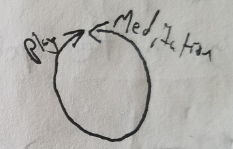Stream of consciousness musings, April 2019.
San Cristobal de las Casas.
Meditation is the act of drawing your awareness–your attention–to what is happening. Just that — what is happening. Not what you want to happen or what you don’t — not what you like or what you don’t.
Practice is a meditation — drawing awareness to specific aspects of your reality — the precision of your technique, the limits of your ability, etc.
But I find that play is the most effective practice. And it’s not clear whether I can say play is a meditation.
My inspiration to pick up the pen just now was this idea: Can we operate in a way that is simultaneously meditation, practice, and play?
⦁ Practice is drawing your awareness to the fine details, the minutia, of that which you are practicing. Not labeling or craving. Just developing awareness of that which is.
⦁ Play is drawing your attention to that which brings you joy and pleasure.
I don’t like that definition of play, yet. I wrote that “play is drawing your attention…” Perhaps better is that play is letting your attention linger on that which gives you joy or pleasure. It’s the play that draws your attention. In play, our attention follows the play — we let the attention flow as it flows naturally. And we find it flows into spaces that drive happiness in the present moment. And if our play is serving as practice, it drives growth — perhaps on a real mastery path if we are play/practicing something we chose intentionally.
But how do we reconcile that practice is a deliberate use of our attention while play is a free-flow of our attention? Can we see meditation as play? Can we see play as meditation?
Perhaps meditation and play exist on a spectrum. In both, we maintain a high level of present moment awareness. In meditation, we maintain a directed control of that awareness. But in play, we let that awareness flow — within the boundaries of our play. We put some boundaries on our attention, and we let our attention wander within that space. But they are the same in our alertness — our attentiveness to the present moment.
Maybe practice is just the act of staying on the spectrum…
What does it mean to move along this spectrum? Maybe narrow boundaries on our attention is more meditative and broader boundaries are more play?
As I ponder these ideas, what am I doing? Am I thinking? Playing? Meditating?
I’m certainly putting boundaries on my attention/awareness. I’m not being attentive to my sensory experience. I’m not noticing smells, sights, body sensations. But I’m certainly alert. I’m attentive to the ideas bubbling in my mind. Am I meditating on the nature of these words and ideas? Am I playing with these ideas? I’m curiously rearranging them and watching for connections and insight.
Maybe the spectrum is actually between practice and play, and meditation is the act of staying on the spectrum.
If this “meditation” on practice, play, and meditation exists on this spectrum, it certainly feels closer to play than to practice. But I engage with ideas in this way on a daily basis — with creative and interesting framings of ideas. In mathematics, in chess, in music… perhaps my practice is to play with ideas.
Practice has become a noun and play has become a verb: my practice is to play. And today, as I play with these ideas of practice, practice has become my play. I like this idea of practice as a noun and play as a verb. A practice is something you are diving into with conviction and consistency. And if you want to have a joyful practice, choosing play as your practice is an easy path to success.
But of course, sometimes our play isn’t practice and our practice isn’t play. So, why do we practice and why do we play? Practice seems driven by conviction toward growth. And play seems to be driven by a desire for joy and pleasure. In most pursuits, these priorities of growth and joy are quite compatible. In developing skills in mathematics, in an instrument, or in writing, it’s hard to find a reason that play and practice are in conflict.
But if our aim is to better understand ourselves — to better understand our experiences of joy and of suffering, perhaps we need to step away from play. We need to look at our experience of joy and suffering impartially — as an observer rather than an experiencer. Perhaps this framing sheds light on the spectrum of play and meditation.
I read Zen Mind, Beginner’s Mind this week and was struck by the notion of posture. In my Vipassana practice, there is very little emphasis on posture. Sit however feels comfortable. By the end of the [10 day Goenka] course, there’s a few hours where they ask you to hold your position, but it’s the position of your choice. But in sitting zazen, you sit lotus. Or if you can’t, you sit as close to lotus as you can. The practice is to maintain the posture with discipline — including spine, neck, core, etc — and then not worry about a particular object of mental focus — just breath in and out.
Trying to sit lotus over the past few days has been quite powerful. I feel like I’m practicing. I’m sitting in closer and closer approximation of lotus, knowing I have a long path of practice ahead before sitting lotus will be comfortable. But it provides a goal that makes sitting to meditate part of my same growth-minded practice cycles re: music/math/language. In the long term, this idea of meditation for gain is one I’ll need to grapple with/reject, but for now, reaching for a challenging posture is pushing me along a useful path.



